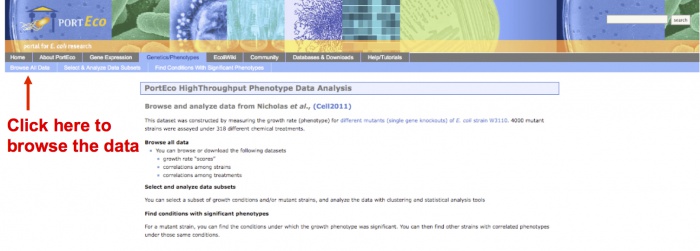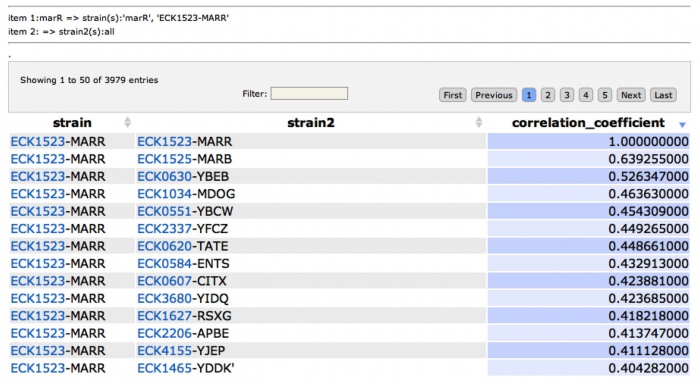Tutorial for Nichols et al. (2011) chemical genomics data
Nichols et al. (2011)[1] determined quantitative growth scores for xx E. coli mutants in 324 conditions covering 114 unique stresses. The xx mutants tested included Keio single gene deletions[2]; essential gene hypomorphs (C-terminally tandem-affinity tagged[3] or specific alleles); and a set of small RNA/small protein knockouts[4]. The results from this study are available for browsing or download at porteco.org.
Contents
- 1 Browsing the data
- 1.1 (1) Start on the PortEco Home Page at porteco.org
- 1.2 (2) Click on "Browse All Data"
- 1.3 (3) You can browse either Strains Or Conditions
- 1.4 (4) To find conditions that affect the fitness of a particular mutant
- 1.5 (5) Partial list of conditions that where marR(del) has reduced fitness
- 1.6 (6) You can search for other mutants that have reduced fitness under the same conditions as marR(del)
- 1.7 (7) Partial list of mutants that are correlated with marR(del)
- 1.8 (8) You can also search for conditions that have similar effects
- 1.9 (9) Partial list of conditions that are correlated with Procaine 10
- 2 References
Browsing the data
(1) Start on the PortEco Home Page at porteco.org
(2) Click on "Browse All Data"
(3) You can browse either Strains Or Conditions
(4) To find conditions that affect the fitness of a particular mutant
(5) Partial list of conditions that where marR(del) has reduced fitness
(6) You can search for other mutants that have reduced fitness under the same conditions as marR(del)
(8) You can also search for conditions that have similar effects
References
- ↑
- ↑ Baba, T et al. (2006) Construction of Escherichia coli K-12 in-frame, single-gene knockout mutants: the Keio collection. Mol. Syst. Biol. 2 2006.0008 PubMed
- ↑ Butland, G et al. (2005) Interaction network containing conserved and essential protein complexes in Escherichia coli. Nature 433 531-7 PubMed
- ↑ Hobbs, EC et al. (2010) Small RNAs and small proteins involved in resistance to cell envelope stress and acid shock in Escherichia coli: analysis of a bar-coded mutant collection. J. Bacteriol. 192 59-67 PubMed








